Together with my friend Feri from Iran, I've been cooking a few Persian dishes while still in Finland. We made a small feast of rice with two different khoresh dishes (Persian term for stews). Of course, it was way too much food for two people, just like a traditional Persian meal should be. Feri told me that her mother would be disappointed when they would finish all the food, because it is seen as a sign that she did not cook enough. Alas, no calorie counting today.
A quick note on the difference between Persian and Iranian. While talking to Feri, I noticed that she consistently used Persian to describe the language and many other cultural traditions. I asked her where Farsi fits in then, to which she answered that Farsi would indeed be more specific and correct. Invoking Persia gives grand connotations of historical Iranian empires in the geographical area of the Persian gulf. According to Wikipedia's disambiguation page for Farsi, Farsi is the indigenous name for Persian.
Feri also wrote the recipes in Farsi for me, so that I could include them here. Thanks Feri!
Persian saffron rice with tahdig
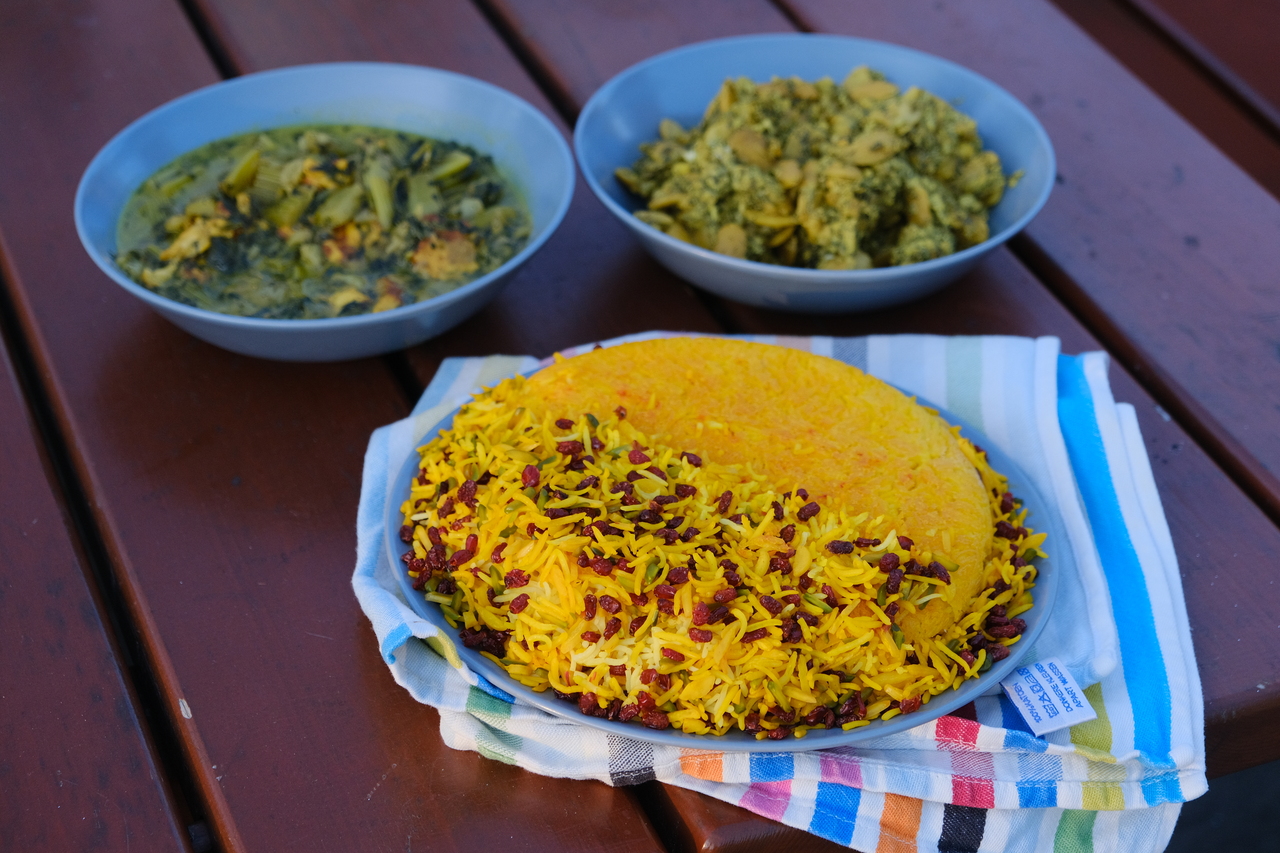
Persian rice with tahdig, served in the afterglow of a summer day, outside my apartment in Otaniemi, 2021.
Rice is ubiquitous in Persian cuisine. The tahdig is a specialty from Iran, referring to a crust on the bottom of the pot. Though a tahdig can also be achieved with bread, potato and vegetables, in this dish aim for a crisp and caramelized layer of rice. People fight over the last pieces of tahdig.
Start by adding rice to a pot and pouring in water until there is a layer of two centimeters on top. We splurged a bit and already added saffron at this stage, together with some salt and olive oil. Cook without a lid on medium heat until the rice is tender, but with body left; basically as soon as there is no hard starchy core anymore when biting into it. Drain the rice (with apologies to all East-Asian people).
Infuse some saffron in cooking water for ten minutes. Mix a good chunk of butter with a few spoons of yogurt, the brewed saffron, and some rice. Spread this into a layer on the bottom of the pot. Pour the remaining rice back on top. Cover with a clean towel underneath the lid to keep the steam inside and cook for forty-five to ninety minutes, depending on your heat (medium to medium-low).
Making a garnish: in a separate pan, toast dried barberries, sliced pistachios, and almonds. After a minute or two, add some of the infused saffron and a couple of spoons of rice. Stir until the water is evaporated.
When the rice is done, turn it around on a plate and drape the garnish in a ring surrounding it.
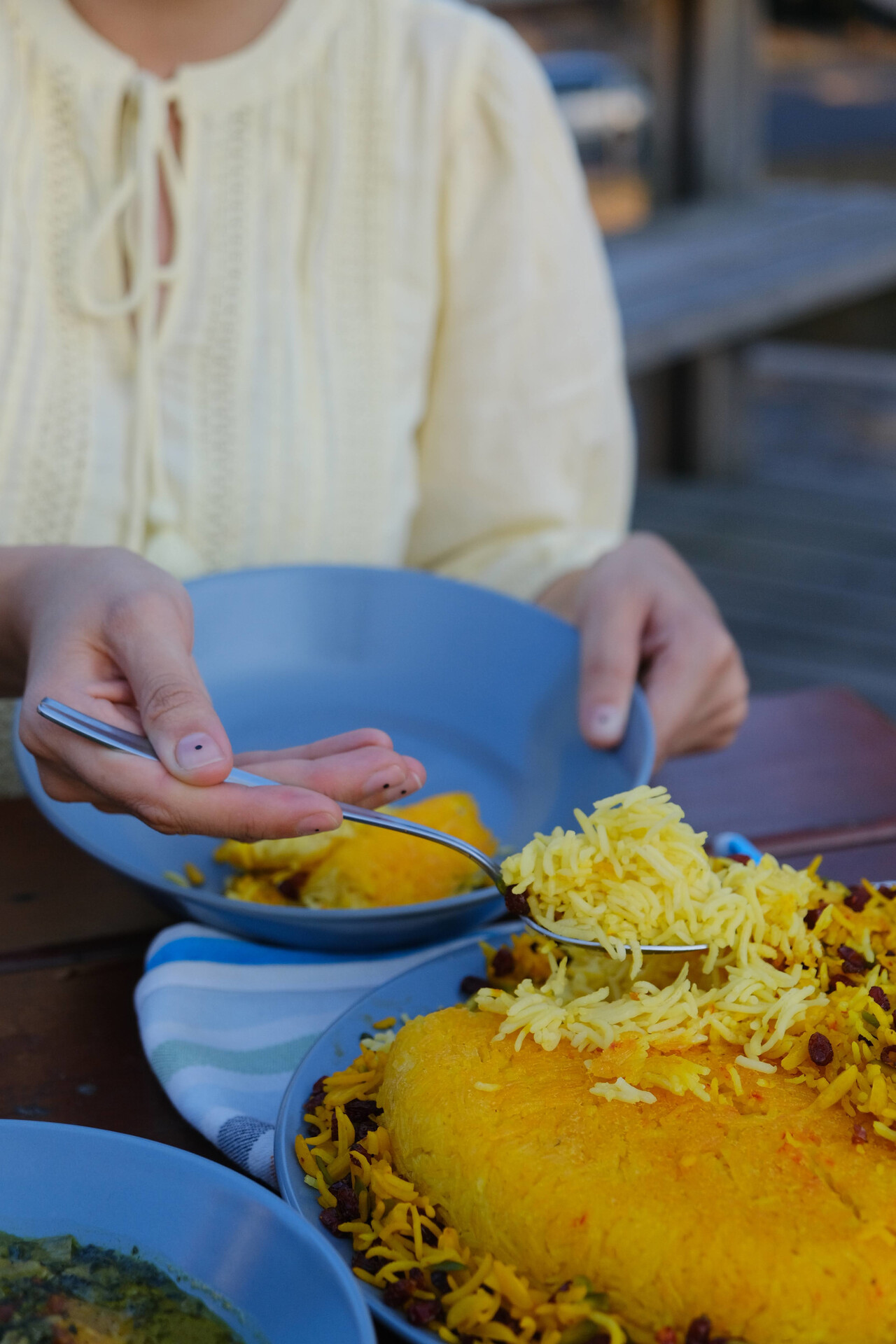
Scooping up some rice with extra tahdig.
برنج زعفرانی با تهدیگ
برنج را توی قابلمه بریزید و روی آن آب بریزید به اندازه ای که حدود ۲ سانتیمتر بالاتر از سطح برنج ها آب باشد. کمی روغن، نمک، زعفران اضافه کنید. اجازه دهید تا روی حرارت متوسط بپزد. وقتی برنجها نرم شدند آنها را آبکش کنید. سپس ۱۰۰ گرم کره، ۳-۴ قاشق ماست، کمی زعفران و کمی برنج را مخلوط کرده و کف قابلمه بریزید و پخش کنید. بعد بقیه ی برنجها را روی آن بریزید و بگذارید دم بکشد. برای تهدیگ مناسب باید ۴۵ دقیقه روی درجه ۳/۶ یا ۱ ساعت و نیم روی درجه ۲/۶ حرارت ببیند.
برای تزیین، کمی زرشک را تفت دهید، سپس زعفران دم شده، کمی برنج، خلال پسته و خلال بادام را اضافه کنید و تفت دهید
Baghali ghatogh
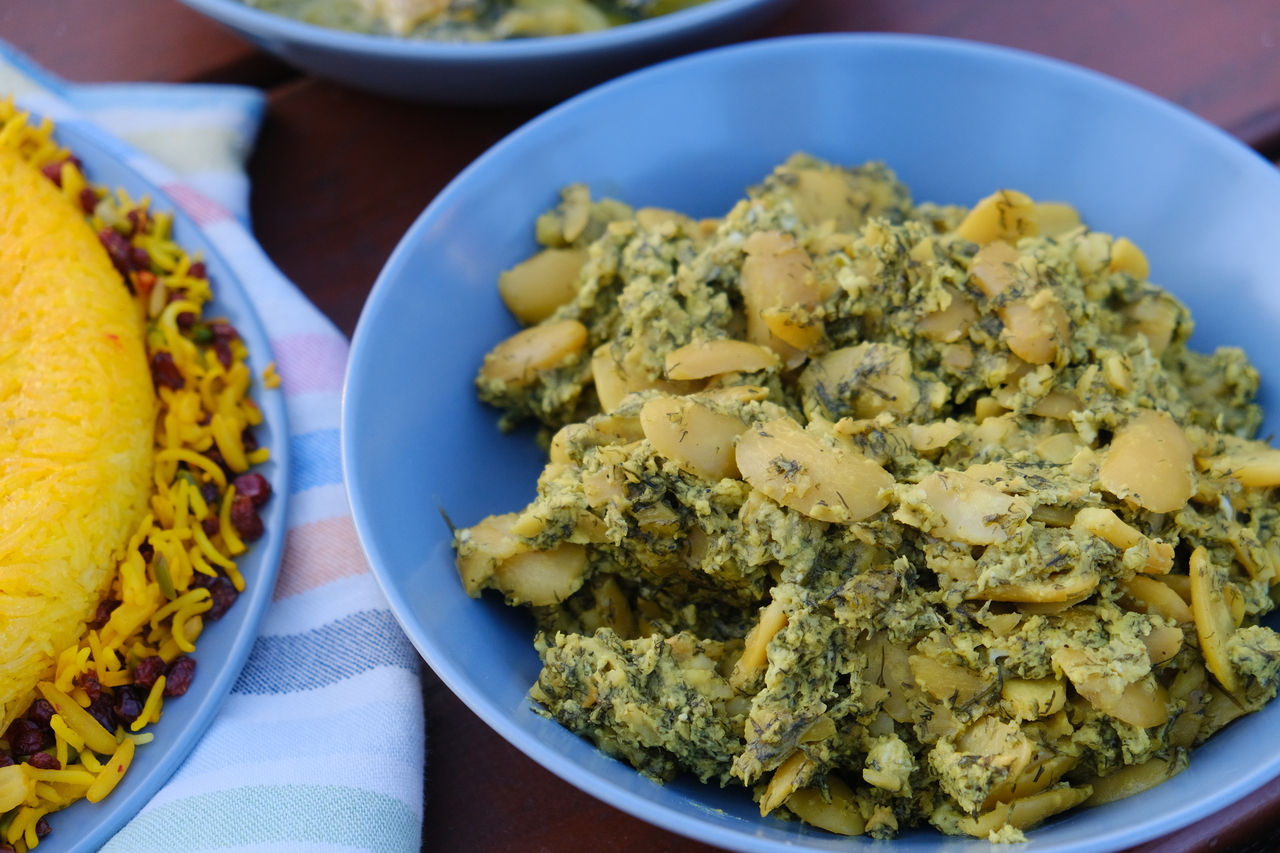
Northern Iranian baghali ghatogh with lima beans, dill, and eggs.
A delicious, vegetarian khoresh from northern Iran (Wikipedia). Traditionally, baghali ghatogh should use arikara beans, soaked overnight. We couldn't find these in Finland, so we used lima beans instead. This dish is spiced with garlic and turmeric.
Fry very finely minced garlic in a good chunk of butter. Add your beans and cook them for a few minutes while stirring. Now we include a whole bunch of fresh dill (and even some dried dill if you fancy), turmeric, black pepper, and salt. Infuse the spices for a moment, before adding water. Let this cook on low heat for an hour, adjusting the level of liquid while stirring from time to time.
You could poach some eggs in the stew near the end, but instead we stirred through the eggs and covered the pan with a lid. This gave it a slightly different texture that Feri prefers.
Serve and garnish with fresh dill.
باقالی قاتق
لوبیای کشاورزی را ۱۲ ساعت در آب بگذارید تا خیس بخورد. بعد از ۱۲ ساعت پوست لوبیا ها را بکنید . ۵ حبه سیر راخرد کرده و ۳۰ ثانیه با ۱۰۰ گرم کره تفت دهید. سپس لوبیا ها رو اضافه کنید و تفت دهید. شوید تازه، زردچوبه (۱ قاشق غذاخوری)، نمک، فلفل و شوید خشک (۳ قاشق غذاخوری) را اضافه کنید و چند دقیقه هم بزنید تا عطر ادویه ها به مشام برسد. حرارت را کم کنید، ۲ لیوان آب را اضافه کنید و اجازه دهید با حرارت کم بپزد. (در آخر میتوانید کمی شوید تازه مجددا اضافه کنید). تخممرغ را اضافه کنید و بگذارید بپزد.
Khoresh karafs
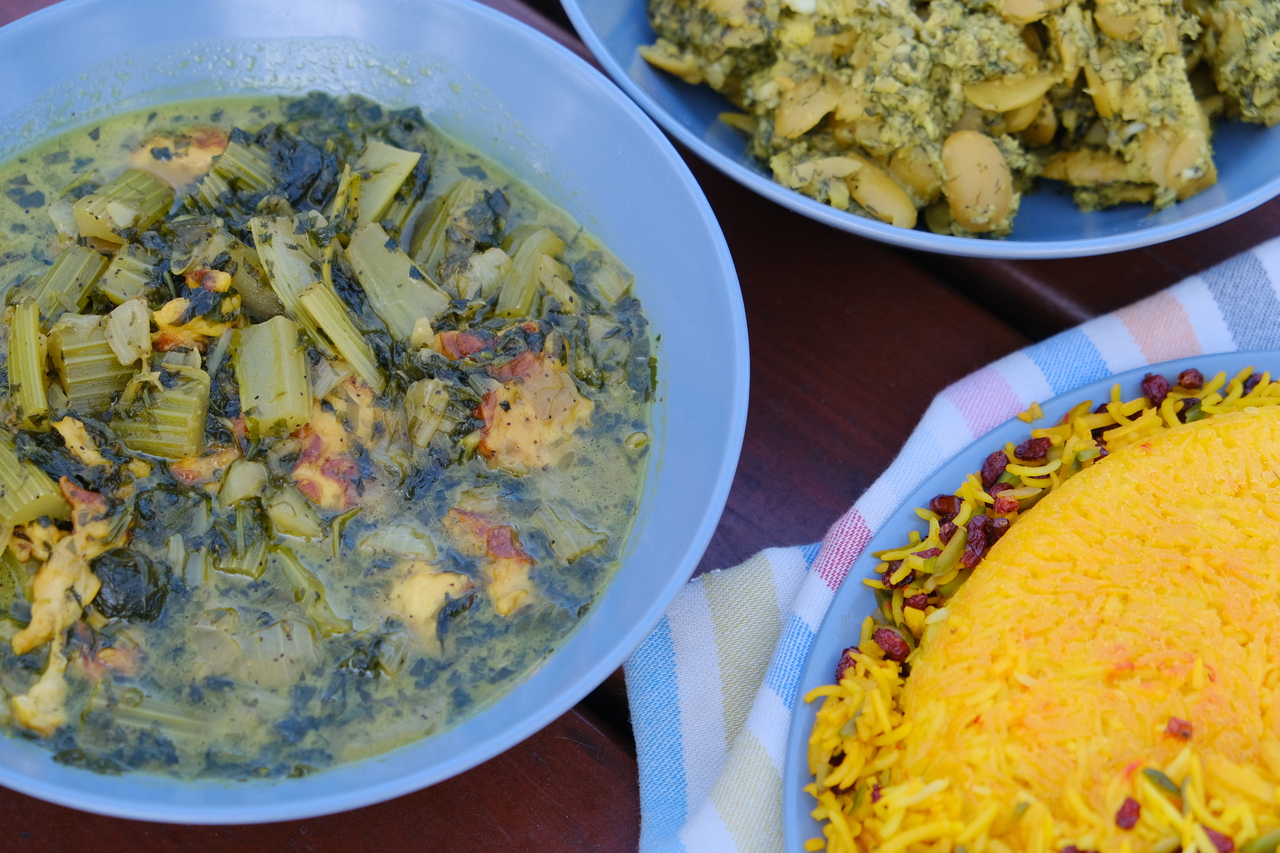
Khoresh karafs but with halloumi cheese instead of meat.
Apparently a rather quick khoresh, with celery (karafs). Normally (or see here) this would be prepared with lamb or beef meat, but we kept it vegetarian with a grilled halloumi cheese.
Chop celery stems in pieces of roughly three centimeters in size. Collect the celery leaves, chop them, and save them for later. Chop a similar amount of parsley, and half that amount of mint leaves. Mince an onion and fry it off in some olive oil. Season with turmeric, pepper, and salt. Add in the grilled halloumi, chopped in pieces, then throw in the celery and stir. Now include all of our herbs and stir for a minute. Pour in some water and simmer the khoresh until celery has softened to your personal preference.
خورش کرفس
پنیر هالومی را گریل کنید و وقتی سرد شد به تکه های کوچک ۳ سانتیمتری تقسیمکنید. ساقه کرفس را به تکه های ۳ سانتیمتری خرد کنید. برگ های کرفس را خرد کنید. به همانمیزان یا مقداری بیشتر جعفری تازه خرد کنید. چند برگ نعناع (کمتر از نصف مقدار جعفری ها) خرد کنید. یک پیاز خرد کرده و با روغن تفت دهید. سپس ادویه (نمک، فلفل و زردچوبه) اضافهکنید. میتوانید مقداری آب اضافه کنید تا پیاز ها نسوزند. سپس تکه های پنیر را اضافه کنید. تکه های کرفس را اضافه کرده و کمی تفت دهید. سپس سبزیهای خرد شده را اضافه کنید و کمی تفت دهید. سپس کمی آب اضافه کنید و بگذارید تا مواد بپزندتا وقتی کرفسها به انذازه ی مطلوب نرم شده باشند.
Kuku sabzi
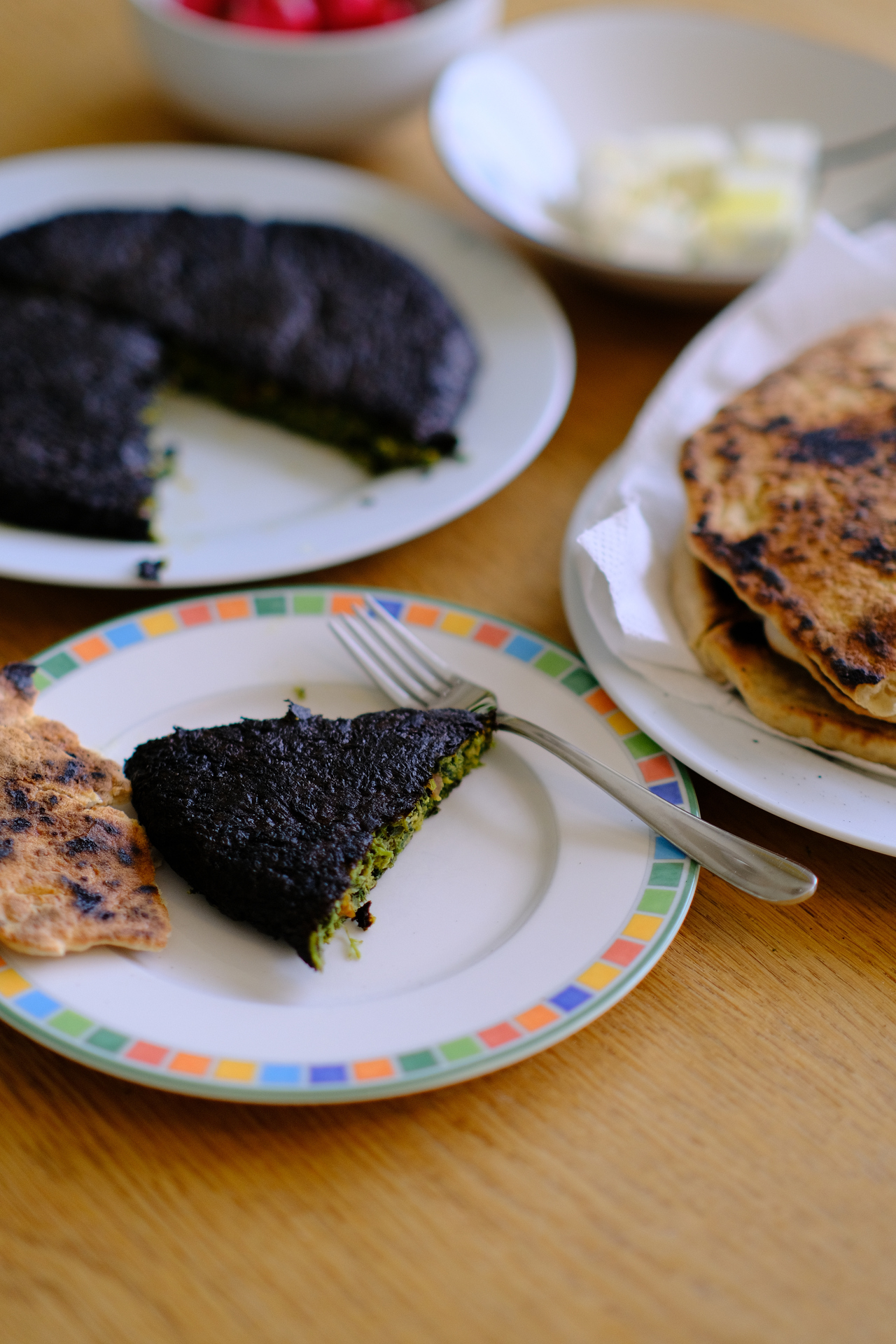
Kuku sabzi, a Persian herb frittata, in my mother's kitchen, Tilburg, 2021.
The Persian herb frittata known as kuku sabzi seems to be a widely-celebrated piece of Persian cuisine. It uses a large bunch of fresh herbs and some eggs to make a delicious center piece for a vegetarian meal. I was recently listening to episodes of the Modern Persian Food podcast in which this dish is also mentioned (episode 28). But more importantly, I ran across some articles written by my favorite Samin Nosrat for the New York Times. She writes about kuku sabzi as part of her series on essential Persian recipes.
My version of this dish is practically the same as Samin's. I served it with freshly baked pita bread, mast-o khiar (see below), radishes, and feta cheese with olive oil.
Though Samin mentions that the crust should be almost black, I found that most pictures online seem to go a little bit easier on the darkness compared to what my kuku sabzi resulted in. Nonetheless, the midnight-black crust tasted rather sweet and not at all pungently burnt.
Mast-o khiar
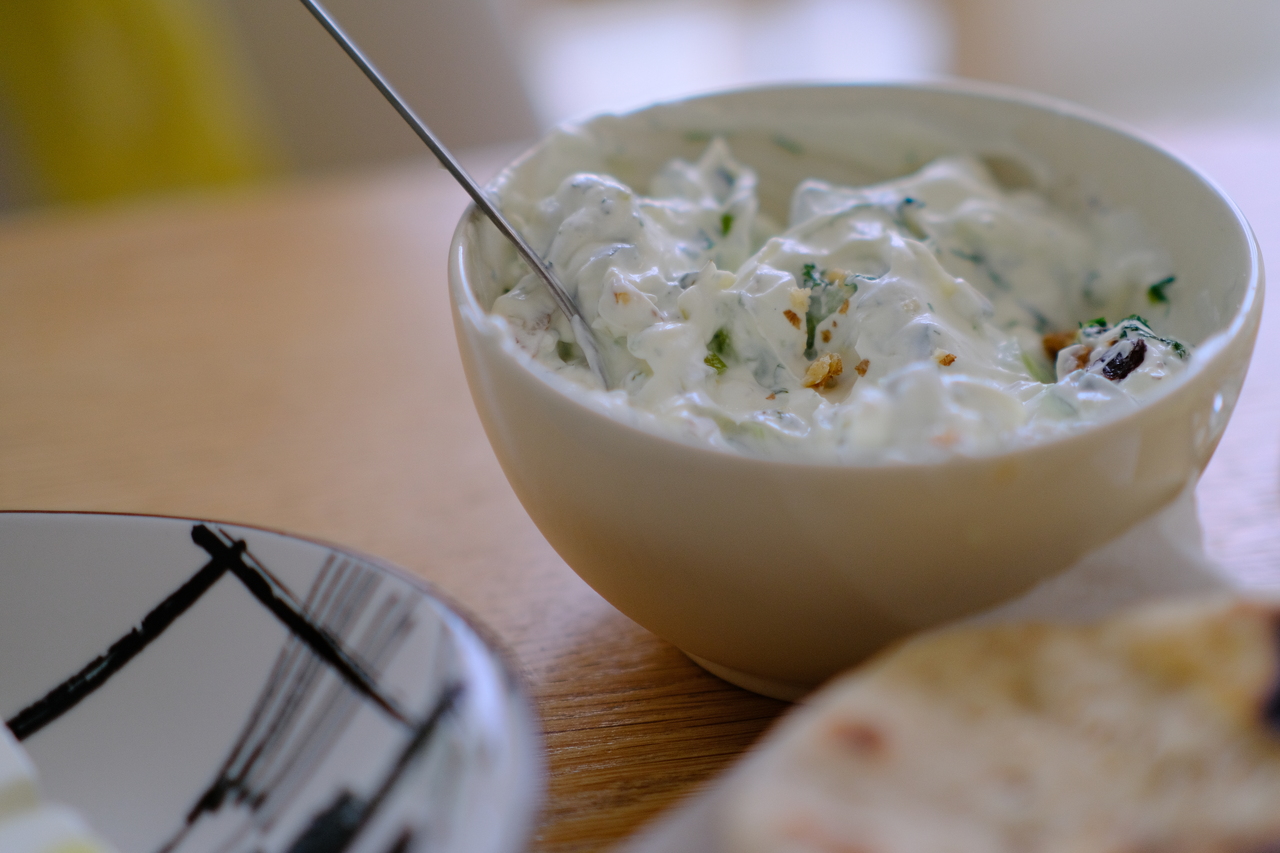
A bowl of mast-o khiar in my mother's kitchen, Tilburg, 2021.
Mast-o khiar is a beautiful, yogurt-based side dish in Persian cuisine. When making it, the thicker the yogurt the better. Preferably use labneh, which is strained yogurt, thus with most of its whey removed, resulting in a thicker consistency.
Because Dutch supermarkets haven't heard of labneh yet, I quickly made my own approximation by straining fatty Greek yogurt in a mesh lined with coffee filters. Place it over a bowl in the fridge for some hours before it is ready to use.
I drew mostly from Samin Nosrat's recipe for the New York Times. Add diced cucumber (less watery than grated), raisins (plumped up by soaking in water beforehand), yogurt, fresh herbs (parsley, cilantro, dill), garlic, salt, and black pepper to a nice bowl. Stir in some walnuts, roughly chopped, right before serving. Works amazingly with many dishes, or just with some good flatbread on its own already.
Kashk-e bademjan
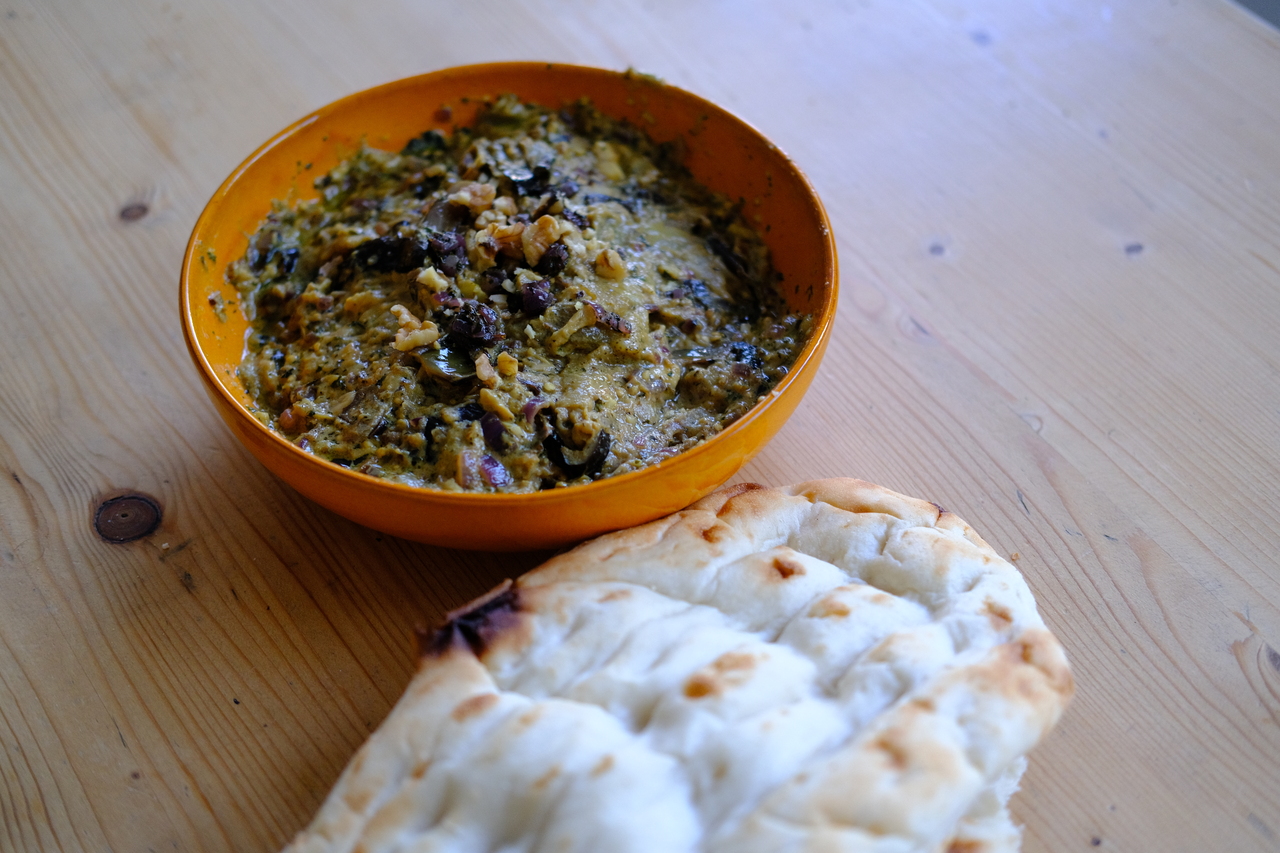
Khask-e bademjan topped with walnuts and caramelized onions, served with lavash, in my apartment in Amsterdam, 2022.
I remember hearing about kashk-e bademjan from some Iranian/American podcasts, in addition to Feri and Navid telling me about this dish. Naturally, because it is a good recommendation for people who prefer to eat no meat.
This dish basically consists of aubergine and kashk. Kashk is a by-product of making cheese, not the whey but rather the curds after cooking. (There is also this amazing little video on making dried kashk balls.) It is actually not that difficult to make this myself, so I want to do that soon-ish too.
I referenced Wikipedia, a recipe by Persian Mama, and an Iranian woman on YouTube.
Prepare the aubergines by salting them and letting them sit for a while (fifteen to thirty minutes). Pat them dry and then sauté them in a sizable gluck of sufficiently hot fat. In a separate pan, slowly sauté and caramelize grated onion. Once the aubergines are fried and soft, start mashing them. Add in the most of the onion, stir in crushed walnuts, turmeric powder, dried mint, and black pepper. Pour in the kashk (if the kashk was dried, first have it rehydrated and brought up to a boil). Loosen it up with some more water if necessary. Let this whole mixture simmer for a few minutes.
Serve on a nice platter, with the remaining onions on top, garnished with roughly crushed walnuts. Eat with some good bread; I had a fresh lavash from a Turkish supermarket.